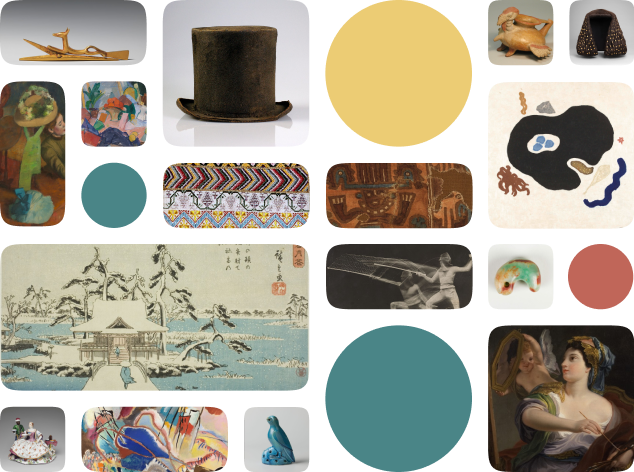Samurai and Wakashu (Male Youth)
Creator Name
Cultural Context
Date
Source
About the work
This piece is a marvelous depiction of the fantasy, eroticism, and multilayered strata of gender presentation that come into play in the ukiyo-e school of the Edo. The painting depicts an intimate interior, with a hanging houseplant and a carpet in contrasting earthy and reddish floral patterns on which different domestic implements are scattered. The intimate and slightly disheveled scenario gives the observer a sense of voyeuristic intrusion into a quarrel between lovers, presenting an interesting power dynamic. To the right, a sitting figure is portrayed as a relatively older man of the samurai warrior class, with accordingly ornate kimono of a light yellow floral and burgundy innermost layer, green obi sash, and a relatively muted red and black 羽織 [haori] jacket. The warrior lord seems to hold a pleading position, grabbing onto the second wakashū (a third gender) figure’s long, flowing 振袖 [furisode] style sleeves. In a visual representation of their power-play, the wakashū youth is standing up to suggest an upper hand in the relationship, with the body turned toward the left edge of the image to suggest that they are decidedly leaving the interaction. The same is suggested by the black and gold obi sash, which appears long and feminine as well as hastily tied up, implying that the figure could have been undressed moments before. The rest of the outfit is extravagant and luxurious, with a pure white underlayer, a gold and black kimono with vertical stripes, and a beautiful crimson overlayer with florals in white, orange, and blues. The ornate hairstyle with the waved seagull’s tail pattern at the nape and high, forward-leaning, mage knot accent of the crown is interrupted by the grayish-purple yarō-bōshi headscarf, waking us from the artifice of the scene by making us aware that the wakashū represented is not actually a third gender youth, but a Kabuki actor interpreting one.
When visiting other pieces in the collection of Japanese art at the Met, we find a striking iconographic coincidence in another hanging scroll titled Kabuki Play Kusazuribiki from the Tales of Soga (Soga monogatari) attributed to 奥村 政信 [OKUMURA Masanobu] (1686-1764). This leads us to believe that Miyagawa's painting has lifted inspiration from a tale known as 曾我兄弟の仇討ち [Revenge of the Soga Brothers] or more simply 曽我物語 [Soga Monogatari], in which two brothers vow to take revenge for their father’s murder. In a retelling of the story, the brother 蘇我五郎 [SOGA no Gorō], wearing clothes that bear a butterfly pattern, is held back by “the tassets of an armor” of the warrior 小林朝比奈 [KOBAYASHI no Asahina] who wears the crane motif on his clothing. This iconography became known as the 草摺引 [Kusazuribiki]. In many inventive and playful works of the Edo, the iconography of the older warrior detaining the younger, more impulsive man by tugging on his clothes―and other gender and sex configurations of the trope―could be a means by which artists explored the power dynamics between presumed lovers, and the audience’s expectations about these, from a somewhat humorous perspective.
When visiting other pieces in the collection of Japanese art at the Met, we find a striking iconographic coincidence in another hanging scroll titled Kabuki Play Kusazuribiki from the Tales of Soga (Soga monogatari) attributed to 奥村 政信 [OKUMURA Masanobu] (1686-1764). This leads us to believe that Miyagawa's painting has lifted inspiration from a tale known as 曾我兄弟の仇討ち [Revenge of the Soga Brothers] or more simply 曽我物語 [Soga Monogatari], in which two brothers vow to take revenge for their father’s murder. In a retelling of the story, the brother 蘇我五郎 [SOGA no Gorō], wearing clothes that bear a butterfly pattern, is held back by “the tassets of an armor” of the warrior 小林朝比奈 [KOBAYASHI no Asahina] who wears the crane motif on his clothing. This iconography became known as the 草摺引 [Kusazuribiki]. In many inventive and playful works of the Edo, the iconography of the older warrior detaining the younger, more impulsive man by tugging on his clothes―and other gender and sex configurations of the trope―could be a means by which artists explored the power dynamics between presumed lovers, and the audience’s expectations about these, from a somewhat humorous perspective.
Metropolitan Museum of Art Object Description
Hanging scroll
Work details
"--" = no data available
Title
Creator
Worktype
Cultural Context
Material
Dimensions
Technique
--
Language
Date
Provenance
Style Period
Rights
Inscription
--
Location
Source
Subjects
Topic
--
Curationist Metadata Contributors
All Works in Curationist’s archives can be reproduced and used freely. How to attribute this Work:
Miyagawa Isshō, Samurai and Wakashu (Male Youth), early 18th century. Metropolitan Museum of Art. This hanging scroll depicts two kabuki actors, one portraying the role of an older man of the samurai warrior class and the other in the role of wakashū, a youth of a third gender distinct from men and women. Public Domain.
Help us improve this content!
Let our archivists know if you have something to add.
Save this work.
Start an account to add this work to your personal curated collection.
